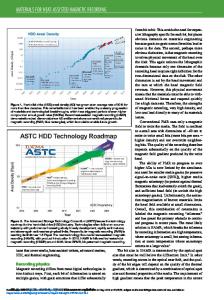High-Performance Polymer Recording Materials for Holographic Data Storage
- PDF / 490,167 Bytes
- 5 Pages / 612 x 792 pts (letter) Page_size
- 71 Downloads / 372 Views
High-Performance
Polymer Recording Materials for Holographic Data Storage Lisa Dhar
Abstract Holographic storage is considered a promising successor to currently available optical storage technologies. Enabling significant gains in both data transfer rates and storage densities, holographic storage and its capabilities have gained a great deal of recent attention. One of the primary challenges in the advancement of holographic storage has been the development of suitable recording materials. In this article, we provide a brief introduction to holographic storage and its potential advantages over current technologies, outline the requirements for recording materials, and survey candidate materials. We end by highlighting recent progress in photopolymer materials that has produced materials that satisfy the requirements for holographic storage and have enabled significant demonstrations of the viability of this technology. Keywords: memory, optical, polymer.
Introduction The upcoming challenges of and demands upon optical storage come from many directions. The next generations of data archiving, digital video, interactive multimedia, and game products all demand continually increasing storage densities and data transfer rates in addition to random access and removability (the ability to separate the media from the drive). Holographic storage is a platform that can provide performance not accessible with commercially available optical technologies.1 In general, optical holography, upon which holographic storage is based, is a method that can record the complete characteristics of a light wave. This recording of information is accomplished by overlapping two coherent light waves to produce an interference pattern. The intensity profile of the pattern, determined by both the phases and amplitudes of the interfering light waves, is imaged into a recording medium to produce a hologram. Either light
324
wave can be regenerated by illuminating the hologram with the other light wave. A familiar example of optical holography is an image hologram recorded in a twodimensional medium, such as a film or sheet, that generates a three-dimensional image. In this case, a reference light wave interferes with the same reference light scattered off of the three-dimensional object whose image is to be captured. Both the intensity of the scattered light (the amplitude) and the distance of different parts of the object to the recording medium (the phase) are recorded. Applying the reference beam to the recording medium diffracts the light from the hologram to reconstruct the original three-dimensional object.2 To apply optical holography to data storage, volume holograms are employed. Here, the thickness of the recording medium is large compared with the characteristic spacing of the interference pat-
tern. In this case, light is selectively diffracted by the recorded holograms. The intensity of the diffracted light reaches a maximum only when the profile of the reference beam matches that used during the recording process. This cond
Data Loading...











